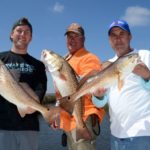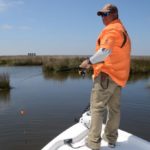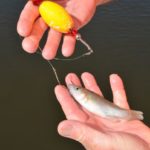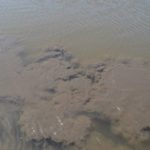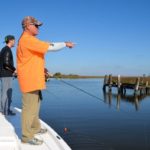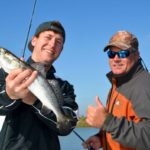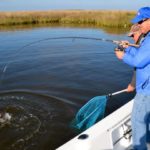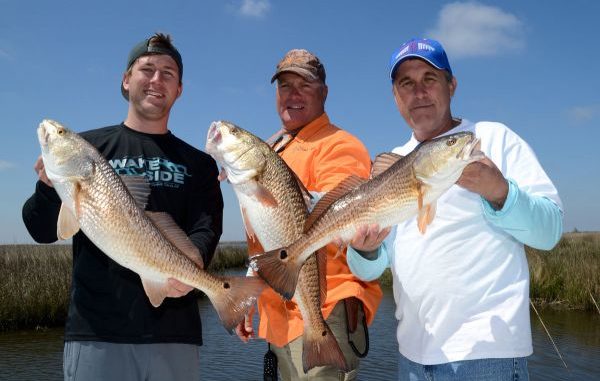
Think it’s too cold to fish? These anglers know it’s the best time of the year to be in Grand Isle catching one redfish after another.
It felt weird.
It was a weekend, but the parking lot was nearly empty. The big pavilion was empty. There weren’t any lines of people waiting for live bait.
No lines at the registers upstairs; no wait for fuel; plenty of open boat slips.
Could this be Bridge Side Marina in Grand Isle — Louisiana’s biggest sport fishing resort town?
It was, indeed. But it was also December.
This same place in July would be throbbing with activity this time of morning. Fifteen to 20 inshore guides and eight to 10 offshore guides would be loading customers, tackle and bait. What seems like hundreds of private boat fishermen would be shouting greetings and jostling their boats for fuel.
But this is Buggie’s time of the year to fish.
During the spring, summer and early fall fishing seasons Buggie Vegas seldom gets to bed before 10 p.m. and is at the marina by 3:30 a.m. to begin serving his customers’ needs.
Even this short window of sleep is interrupted when problems arise with his live-bait systems that hold thousands of shrimp, cocahoe minnows and croakers.
But on this day, he was hitching a ride with Keith “Herk” Bergeron, owner of Pair-A-Dice Charters of Grand Isle (985-860-7855).
“I go fishing when the guides in the marina go scouting,” Vegas laughed. “I invite myself.”
Bergeron and Vegas were joined by Vegas’ look-alike son, Robert. The trio took their time getting ready to leave, one of the perks of wintertime fishing. You don’t have to leave super early to beat the heat.
“If they knew how good wintertime fishing was here,” Bergeron volunteerd in his low-key way, “more people would come — especially those that don’t like crowds.
“The only thing is that your trip has to be almost spur of the moment because of winter winds (the elder Vegas agreed). It’s hard to plan a trip far in advance.”
Although they were likely to pick up some speckled trout during the day, Bergeron predicted the fishing would focus around redfish.
“You can catch reds anytime of the year,” Bergeron said.
“Yeah,” Buggie agreed, “we on the island take redfish for granted. They are a really fun fish.”
“A hard fighter in shallow water,” Bergeron interjected.
Buggie couldn’t disagree, and his son nodded agreement.
“They are a lot stronger fish than speckled trout,” the elder Vegas said. “They are good eating, too — fried, blackened, courtbouillon, and grilled on the half shell.”
Bergeron guided his Blue Wave Pure Joy out of the marina and pointed it north. The 24-footer can float in 12 inches of water — perfect for the kind of fishing he anticipated for the day.
From the marina, he piloted the boat north-northwest for the 11-mile run across Caminada Bay, Bay Tambour, Fisherman’s Bay, the twin pipelines and through Oaks Bay, and into the bayous and canals northeast of Bay Rambo.
It was welcome relief when Bergeron slowed the boat to an idle in the bayou. In spite of cobalt-blue skies, the morning was cold, especially so in his 300-horsepower-propelled boat.
“We are going to throw at the banks for redfish and in the middle of the bayous for trout,” the 55-year-old guide explained. “Right now the fish are looking up to the surface to feed. In the winter, they feed nearer the surface. In the summer, the water is hot near the top, and they feed deeper.”
The veteran guide has 17 years of experience fishing for his specialties — speckled trout and redfish out of Grand Isle, both with conventional and fly tackle.
After growing up in Abbeville, he moved to Baton Rouge to work in construction, which is where he picked up his nickname
“Herk” is short for “Hercules.” At that time, he worked out vigorously, and developed massive shoulders and arms, a trait he still carries. Once when a job needed heavy lifting, one of the other construction workers quipped, “Get Hercules over there.”
The name stuck.
During his Baton Rouge years, he worked four 10-hour days each week, and he began fishing in Grand Isle three days virtually every weekend.
He explained drily why he left construction.
“I was working in a plant when 9-11 (the terrorist attack on the World Trade Center) happened,” Bergeron said. “I made up my mind that I didn’t want to die in some plant from a terrorist attack.
“I was already fishing here every weekend, so I just moved here.”
Taking the guide’s cue, Buggie and Robert picked rods rigged with corks and put live cocahoe minnows on the hooks. In spite of the sharp chill in the morning air, it didn’t take long for the pair to hook up.
“There he is,” yelled Buggie, as a near-27 inch redfish slammed his minnow.
As soon as Bergeron netted the fish for him, Robert responded to his dad with a nice speckled trout taken from the middle of the bayou.
The pair went back to their routine. After Buggie knocked down another redfish and son Robert nailed another speck, the slow-talking guide put one hand on his hip.
“I’m the guide and I can’t catch a fish,” Bergeron drawled.
After a few more casts from his perch on the bow deck, he grinned good-naturedly.
“Maybe the problem is that I don’t have a minnow on,” he said.
He moved to the back of the boat, pulled off his plastic-tipped jig and netted a cocahoe.
“I’m not stupid. I like minnows,” Bergeron said.
The area they were fishing could almost be described as scenic, compared to so many of the heavily eroded landscapes in coastal Louisiana. For the most part, bayous were still identifiable as bayous, canals as canals and ponds as ponds, rather than being a vast sheet of water 12 inches deep with scattered clumps of marsh grass.
The bayou and canal banks were sprinkled liberally with family fishing and hunting camps. Bergeron told the men to fish hard in front of each camp.
“A Cajun never builds a camp where he can’t catch fish off the porch,” he said. “I catch a lot of fish near camps.”
Bergeron spent a lot of time standing quietly on the bow without casting, staring intently through his polarized sunglasses at the shoreline as he trolled the boat along it within casting distance.
He was searching for targets.
“I love it when I see not just sign of a fish but the whole fish,” Bergeron said. “You have about 3 seconds to get a cast off before it’s gone. They can see you, too. That’s why I stand ready to cast rather than simply blind cast.
“The water can’t be too clear for redfish. All they do is get brighter orange.”
But sign of fish is mostly what he was searching for. The V wake made by the dorsal fin of a fish moving in shallow water is a dead giveaway. Sometimes when a redfish noses the bottom, the tip of the upper tip of the tail breaks the water’s surface.
“If the wind is blowing, it will make a wave pattern on the water,” Bergeron explained. “A single fish in the shallows will create a different pattern in the waves. If baitfish are running or grass shrimp are jumping, a fish is chasing them. A mullet constantly jumping means that a fish is after it.
“When I see a redfish, I throw at least 5 feet ahead of it, especially if I am using a cork. Then I wait for them to swim to the bait. A spinner is a little better than a cork.”
If a red can see the cork flying through the air, it’s game over.
“Redfish see the cork coming and think that it’s a bird. They are born with the instinct to escape predators, and their biggest fear is birds,” Bergeron said. “They don’t outgrow that fear. If you spook a redfish, it is almost impossible to catch it.”
Bergeron made many of his casts side-arm rather than overhead to reduce the profile of a shadow descending from the sky. He alternated between stop-and-go and slow steady retrieves.
“I pop the cork a lot harder in the summer,” he said. “They are a lot more aggressive then. In the winter, they are sluggish from the cold, so I just give them gentle pops.”
Starting from a cold morning, the day blossomed beautifully. Under blue skies flecked with wispy tufts of clouds, the trio soon peeled off their jackets and reeled in fish.
Robert Vegas, especially, seemed to have a horseshoe in his pocket. He spent half the morning texting on his cell phone, while the two older men fished continuously.
Yet he caught as many fish as the other two did combined.
Robert texted a while, then picked his rod and immediately caught a redfish. Then he texted some more, picked up his rod and caught a couple of speckled trout.
Dad Buggie shook his head and laughed.
Bergeron continued his tutorial.
“Reds bite as long as the tide is moving, either up or down,” he explained. “They feed in currents because they want their food brought to them. That’s why you fish points (on the shore) and cuts (in the bank).
“Fishing is good in the shallow water of marsh ponds, too, but you need a high tide to get in them.”
The tide was rising continuously as the men fished.
When he thought that enough water was in the ponds to float his boat, Bergeron turned its bow into a cut in the grass to ease it into a slough leading into a pond.
Before heading into the shallows, however, he closed the intake to his live baitwell and switched it to recirculating mode to prevent the intake from picking up the dense clouds of mud churned up from the pond bottom by his trolling motor.
The tactic paid off. In a matter of minutes, they nailed one, two, three redfish, one behind the other.
After posing for the required hero photograph of the triple, Bergeron wiggled the boat out of the skinny water and into the bayou.
Their day was done.
